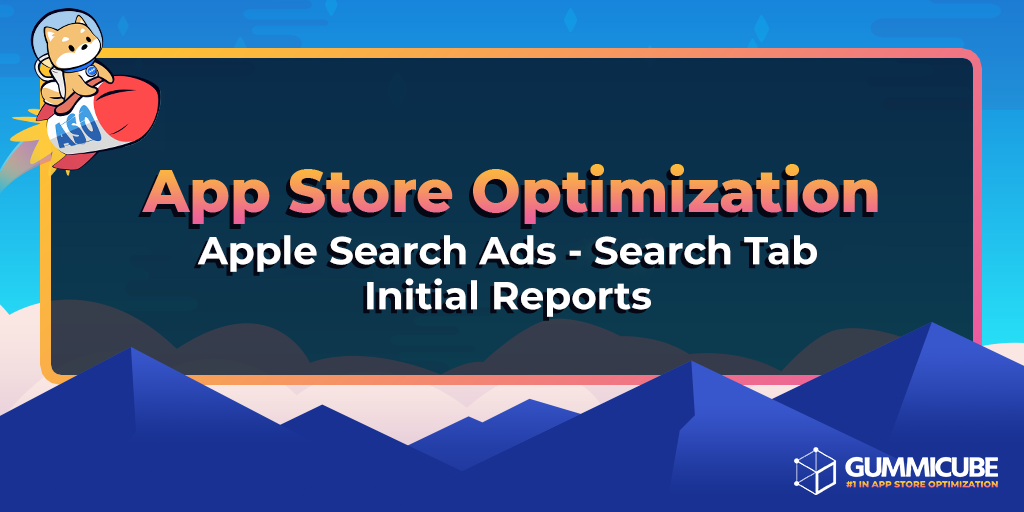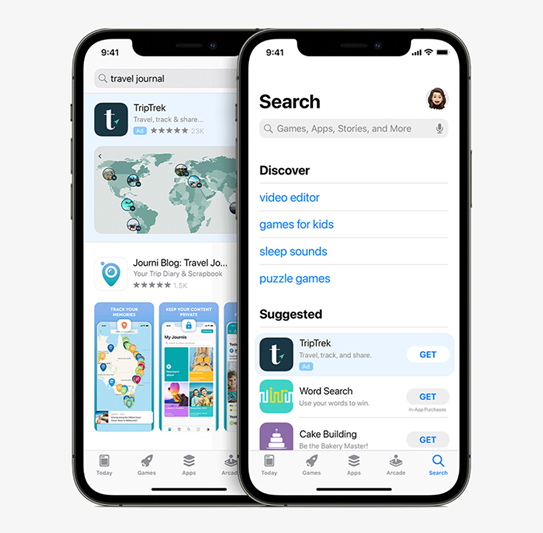App Store Optimization – Apple Search Ads: Search Tab initial reports
- Monday, July 26th, 2021
- Share this article:
Dave Bell, Co-founder and CEO of Gummicube, looks at early results from Apple Search Tab Ad campaigns. In May of this 2021, Apple launched a new ad placement on the iOS App Store. Search Ads can now appear in the “Suggested” section of the search tab, before a user enters a search query. This new ad placement comes in close conjunction with another change to advertising on the iOS App Store: Apple’s App Tracking Transparency framework, which disables tracking without a user’s explicit opt-in consent.
In May of this 2021, Apple launched a new ad placement on the iOS App Store. Search Ads can now appear in the “Suggested” section of the search tab, before a user enters a search query. This new ad placement comes in close conjunction with another change to advertising on the iOS App Store: Apple’s App Tracking Transparency framework, which disables tracking without a user’s explicit opt-in consent.
The rollout of App Tracking Transparency left some developers questioning where to spend their advertising dollars in the “post-adpocalypse era” and how to adjust their App Store Optimization
strategy. With Apple simultaneously rolling out a new type of native App Store ad placement, developers may want to launch a test campaign there. Below are some initial reports from developers surveyed on this new placement as a benchmark of what to expect in the early stages of this new advertising frontier.

An example of a Search Tab placement (right) next to a search result placement (left) on Apple Search Ads. Source: Apple.
Early insights and behavior to consider
While it is early on to fully assess the efficacy of Apple Search Tab Ads, there is now enough data back for developers to offer preliminary insight on how campaigns are performing. No two ad networks will perform the same, but assessing metrics from Apple Search Tab Ads against standard Apple Search Ads, including the conversion rates and cost, can provide a comparison of what to expect.
A direct comparison of conversion rates for a Search Tab and Search campaign will not give a full view of potential performance. User behavior is different on the Search Tab vs Search results; when a user taps on the Search Tab, they haven’t provided context as to what they are looking for yet. Inherently, a standard Search Ads campaign that appears after a user performs a search means the intent of a user to find a relevant app is there.
When looking to compare metrics, it’s best to think of the Search Tab more like “App Store Browse” traffic from the Today Tab or a top-ranking chart, and traditional Search Ads as “App Store Search” traffic (in fact, Apple bundles true organic search with Search Ads metrics together in App Store Connect).
The exposure opportunity from a Today Tab placement is high, but due to a lack of specific user intent – even if the user is shown apps based on other apps they’ve installed – conversion ratios will inherently be relatively lower than those of a search result. With that in mind, here are early metrics as reported by developers surveyed across a variety of genres, including Business, Shopping, Games and Kids categories and more.
Conversion
Exact figures vary depending on an app’s category, but in general, Apple Search Ads search campaigns average around a 30-60 per cent conversion rate. While it also varies by category, conversion rate for an Apple Search Tab Ads campaign is reported to average between less than half of one per cent, to 0.01 per cent. Apps with an established brand tend to trend above this range, with games or apps made with kids in mind being on the higher end as well. In general, this conversion ratio is a good benchmark to keep in mind.
This rate seems low, but keep in mind the above caveats about user behavior. A user seeing your ad – or any app – on the Search Tab will have the intent to look for a new app, but not have yet entered their specific search intention. Conversion rates here compared to those of a search result Search Ads campaign may seem low, but understanding that this is typical for this kind of campaign can help provide a better understanding of how a campaign is performing relative to the market.
Cost
Apple’s Search Tab Ads are structured with a different pricing model than standard Search Ads, utilizing a Cost Per Thousand Impressions model (CPM). For standard Search Ads, developers don’t pay for Impressions – they only pay once a user taps on the ad using a Cost Per Tap (CPT) model.
While the models themselves are different, both Search Tab and traditional Search Ads report on Cost Per Tap (CPT) and Cost Per Acquisition (CPA). In the current early stages of Apple Search Tab Ads, and depending on the category, developers are reporting campaigns show an average CPT of $5-12. Comparatively, they report an average CPT of Search Result Ads can be between $1-4.
That’s only for the tap – the cost to acquire a user after the tap is a critical metric to evaluate for both types of Search Ads campaign. For Apple Search Tab Ads, CPA is reported at around $10-35. Compare that to the reported CPA of a Search Results campaign, ranging around $2-8, with some categories like Games and Kids again generally coming in at a lower cost while other categories like Finance and Business coming in above the average range.
Overall
Preliminary findings show Apple Search Tab Ads are more expensive and less effective than standard Apple Search Ads when it comes to conversion, when viewed in a vacuum or compared to Search Results campaigns. That being said, winning a placement here can be a great opportunity for exposure, since all users, regardless of search intent, may see the ad. Apple seems to be aware of this, as it is reflected in the change of their pricing model from CPT to CPM on this new type of campaign.
Similar to an app being seen on App Store Browse or in featured lists, Apple Search Tab Ads will place the ad in front of a large audience. In these scenarios, the impressions can skyrocket, while user intent, and therefore conversion, is likely to remain relatively low. Understanding this, and what a typical range might be going into the launch of a campaign, can help developers better assess how they are performing relative to other apps in the market.
Apple Search Tab Ads are still relatively new. As more data comes back on performance and developers adjust their App Store Optimization strategies, metrics will shift over time. Some apps in some categories will find more success here – currently already-known brands and Games and Kids apps which appeal to wider demographics appear to be performing well in this placement relative to other categories.
As performance data continues to come back and strategies change across the App Store, be sure to assess how your app is performing against currently known benchmarks and continue to research how the industry evolves.
About the Author
Dave Bell is Co-founder and CEO of Gummicube. Gummicube is a global leader in App Store Optimization with more than 11 years of experience optimizing and marketing apps. We offer the leading enterprise ASO technology and agency services, providing support to clients around the world. Our company is trusted by thousands of enterprise brands and leading startups including Microsoft, LinkedIn, Bethesda, SWEAT, GrubHub, McAfee and many others.
















